At its core, ceramics consists simply of dirt that is mixed with water and shaped by the human hand. With a mastery of technique, however, artists can transform clay into works of art that are both structurally innovative and thought-provoking. The 2008 Taiwan Ceramics Biennale (臺灣國際陶藝雙年展), which opened on June 26 and runs until Dec. 7 at the Yingge Ceramics Museum (臺北縣立鶯歌陶瓷博物館), pays tribute to the ability of artists to create art from one of the most basic and elemental mediums.
This year marks the third time the Biennale, which was founded in 2004, brings together ceramics artists and scholars from around the world. Artists from 58 countries entered 684 ceramic pieces into this year’s competition. From that number, 114 works from 24 countries were selected for the exhibit, and 19 artists were honored with awards at a ceremony last Friday.
Taiwanese ceramics artist Chu Fang-yi’s (朱芳毅) piece Memory, Sign and Record of Objects (物件記憶•記號•紀錄) is this year’s recipient of the Taiwan Ceramics Award Grand Prize (台灣陶藝獎). The work consists of 25 black-and-white ceramic objects arranged in neat, orderly rows on a wall. The inspiration for the ceramic objects, which vaguely resemble familiar household wares like pots or teacups, represent Chu’s own experiences, but he kept the pieces simple and abstract to encourage viewers to develop their own interpretations.
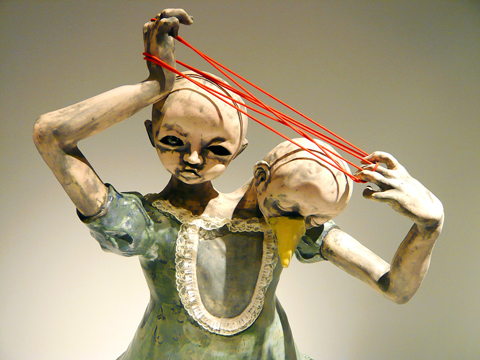
PHOTO: CATHERINE SHU, TAIPEI TIMES
The work was also inspired by Chu’s interest in ancient Chinese pictograph writing, and oracle bone script in particular.
“When modern-day people see these images and objects, they can still attempt to decode it and glean their own meaning from it, or discuss their interpretation with other people, so that it becomes a channel for communication,” says Chu. “That is something that I wanted to incorporate into my work.”
Chu, who studied ceramic art at Tainan National University of the Arts (國立臺南藝術大學) and participated in the Biennale for the first time this year, says that one of the attractions of ceramics as a medium is the unique tactile experience it offers.
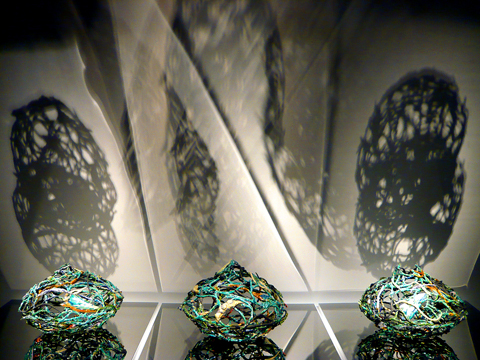
PHOTO: CATHERINE SHU, TAIPEI TIMES
“When I began studying ceramic arts, I really liked the feeling of the clay in my hands,” says Chu, “It felt very comfortable, and working with clay means that you get to have a very immediate, intimate contact with your work.”
The Biennale exhibit is grouped into four sections, each focusing on different themes in the artists’ work.
Vessels, Decoration, Conveyance highlights the creativity and diversity of pieces created in the shape of a vessel, one of the most basic ceramic forms, while Form, Space, Void and Substance focuses on more abstract pieces. Figures, Life, Concern gathers together representations of the human body, and Objects, Assemblies, Installations presents installations that consist of multiple ceramic pieces, including Chu’s Memory, Sign and Record of Objects.
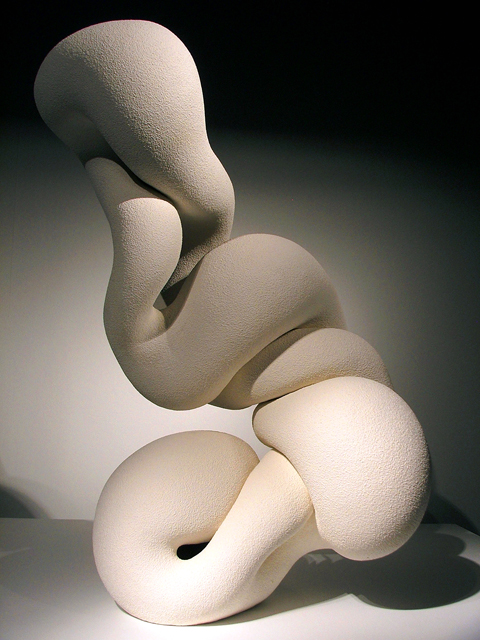
PHOTO: CATHERINE SHU, TAIPEI TIMES
Finalist Eric Nathan Landon, an American artist who has lived and worked in Denmark for the last nine years, entered his wall installation, Mimic, into the Taiwan Ceramics Biennale after seeing a poster for the event at the Danish School of Design. Mimic, which is made up of more than 500 wheel-thrown vessel-shaped objects that resemble mouths, is meant to be a commentary on “our culture of self-obsession” where, for example, individuals seem much more invested in editing their MySpace profiles than in creating a sense of community with the people around them, says Landon.
Landon says that he enjoyed learning more about Taiwanese ceramic art.
“In Danish institutions, students are encouraged to work to a goal, and to not try too many things,” says Landon, “Based on what I’ve seen, experimentation is really alive here.”
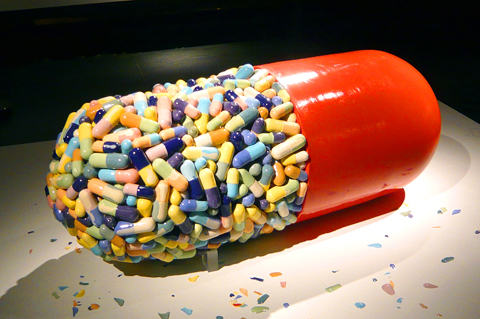
PHOTO: CATHERINE SHU, TAIPEI TIMES
Other works to watch out for at the Biennale include South Korean artist Lee Chun-bok’s Gold prize winner Hidden Space, a porcelain piece whose airiness, simplicity and graceful curves belies Chun’s technical mastery, and Without Title by Dutch artist Paula Bastiaansen, which resembles an unfurling nautilus shell. Spainard Xavier Monsalvatje’s Pulse, Press is a ironic pastiche of a Ming vase where a figure in a gas mask replaces traditional motifs, while Double Basin by American Jennifer Woodin calls attention to the quotidian elegance of the humble plumbing fixture.
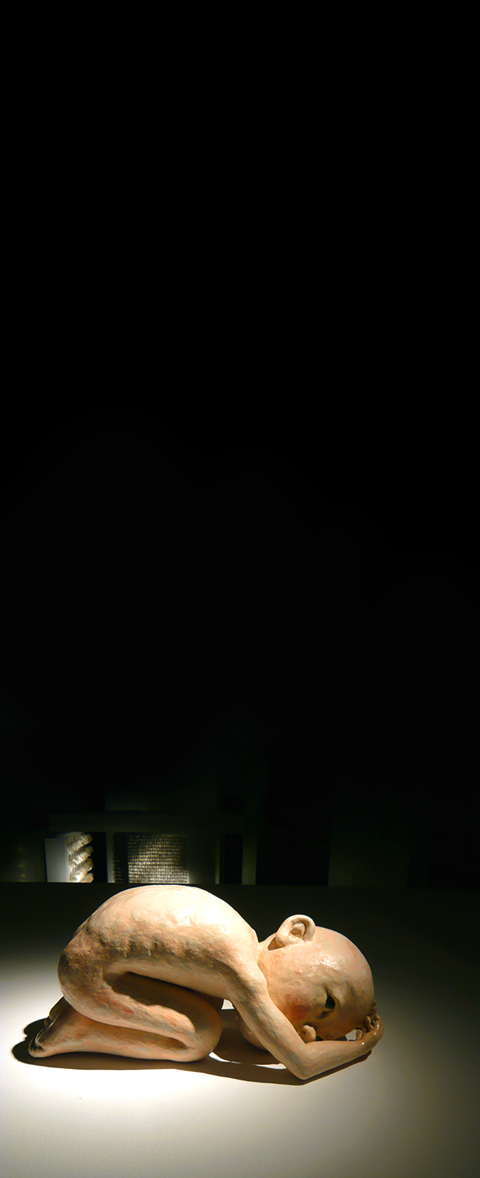
PHOTO: CATHERINE SHU, TAIPEI TIMES

April 28 to May 4 During the Japanese colonial era, a city’s “first” high school typically served Japanese students, while Taiwanese attended the “second” high school. Only in Taichung was this reversed. That’s because when Taichung First High School opened its doors on May 1, 1915 to serve Taiwanese students who were previously barred from secondary education, it was the only high school in town. Former principal Hideo Azukisawa threatened to quit when the government in 1922 attempted to transfer the “first” designation to a new local high school for Japanese students, leading to this unusual situation. Prior to the Taichung First

The Ministry of Education last month proposed a nationwide ban on mobile devices in schools, aiming to curb concerns over student phone addiction. Under the revised regulation, which will take effect in August, teachers and schools will be required to collect mobile devices — including phones, laptops and wearables devices — for safekeeping during school hours, unless they are being used for educational purposes. For Chang Fong-ching (張鳳琴), the ban will have a positive impact. “It’s a good move,” says the professor in the department of

On April 17, Chinese Nationalist Party (KMT) Chairman Eric Chu (朱立倫) launched a bold campaign to revive and revitalize the KMT base by calling for an impromptu rally at the Taipei prosecutor’s offices to protest recent arrests of KMT recall campaigners over allegations of forgery and fraud involving signatures of dead voters. The protest had no time to apply for permits and was illegal, but that played into the sense of opposition grievance at alleged weaponization of the judiciary by the Democratic Progressive Party (DPP) to “annihilate” the opposition parties. Blamed for faltering recall campaigns and faced with a KMT chair

Article 2 of the Additional Articles of the Constitution of the Republic of China (中華民國憲法增修條文) stipulates that upon a vote of no confidence in the premier, the president can dissolve the legislature within 10 days. If the legislature is dissolved, a new legislative election must be held within 60 days, and the legislators’ terms will then be reckoned from that election. Two weeks ago Taipei Mayor Chiang Wan-an (蔣萬安) of the Chinese Nationalist Party (KMT) proposed that the legislature hold a vote of no confidence in the premier and dare the president to dissolve the legislature. The legislature is currently controlled